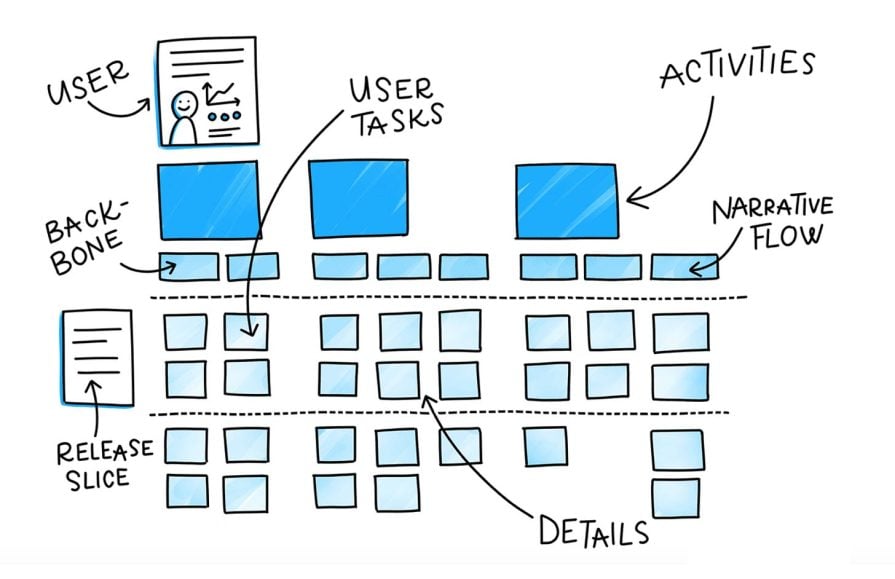
Knowing where to land is fundamental but it’s not enough on its own.
Once you clarify the goal, you need to define what needs to happen to progress.
For decades, this was achieved through requirement engineering, which took months while a few people wrote the specifications. This mountainous task happened before development to identify the right things to do. Yet, it led to frustrations, as creating digital products is unpredictable, and also it led to a considerable amount of risk, since so much work needed to be done upfront.
Agile came along to change that. Instead of treating software development in phases, it became an iterative approach, improving based on learning and knowledge. Yet, it doesn’t change the fact that people need to align on how to progress.
A simple and great starting point is having a user story workshop.
A user story workshop is where the whole product team and relevant stakeholders get together to build a shared understanding. You start with the goal and then explore users’ problems and opportunities and what they aim to achieve. The result is clarity on how to progress while understanding the problem space.
Unlike classic requirement engineering, the user story workshop is fast-paced and collaborative. It takes hours instead of months, and everyone collaborates instead of having specific roles. In addition, it’s a starting point that will change throughout the digital product’s journey.
Let me clarify one common confusion. User stories are not a one-to-one conversion of classic requirements. The ultimate goal of user stories is to create mutual understanding of the problem teams solve. Instead of blindly following requirements, teams solve problems and understand why.
It’s common to confuse user stories and forget how to use them. Understanding the 4 Cs is the key to benefiting the most from user stories:
To run an outstanding user story workshop, you’ll need only three things:
I cannot emphasize how important it is to prepare for the workshop. That said, here are some additional steps that you should take to run the workshop successfully:
Jeff Patton is the creator of user story mapping. It helps teams build a shared understanding of the problem and what to tackle. I love using it for user story workshops.
You can watch this video about user story mapping or understand it using the following image:

So, how do you run the show?
As you finish your story mapping, you can convert the user tasks into user stories.
It’s easy to misuse the user stories techniques and have watered-down solutions. Here are a few tips for you to succeed with it:
User stories heavily depend on you applying the four C’s well: Context, card, conversation, and confirmation. Workshops, preparation, and collaboration are also fundamental to thriving with user stories. User story mapping will help you see the big picture, but you should not treat that as final but as the starting point.
Remember to use these techniques to foster collaboration, not to limit it. Don’t write “solution” stories. And always keep the user perspective as the focus.
Featured image source: IconScout

LogRocket identifies friction points in the user experience so you can make informed decisions about product and design changes that must happen to hit your goals.
With LogRocket, you can understand the scope of the issues affecting your product and prioritize the changes that need to be made. LogRocket simplifies workflows by allowing Engineering, Product, UX, and Design teams to work from the same data as you, eliminating any confusion about what needs to be done.
Get your teams on the same page — try LogRocket today.

Most teams fail at autonomy. Learn how clear rules help product teams move faster without micromanagement.

A practical framework for PMs to use AI in ideation without sacrificing judgment, strategy, or decision quality.

A practical five minute revenue estimation method to help product managers compare ideas, drop low impact features, and prioritize smarter.

A practical guide for PMs who want to stop being bottlenecks, delegate smarter, and lead teams effectively with a clear ownership framework.